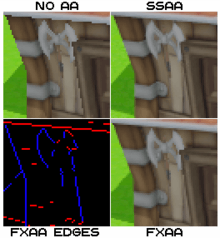Fast approximate anti-aliasing
Fast approximate anti-aliasing (FXAA) is a screen-space anti-aliasing algorithm created by Timothy Lottes at NVIDIA.[1] It is also referred to as fast sample anti-aliasing (FSAA).
FXAA 3 is released under a public domain license. A later version, FXAA 3.11, is released under a 3-clause BSD license.[2]
Comparison

The main advantage of this technique over conventional spatial anti-aliasing is that it does not require large amounts of computing power. It achieves this by smoothing undesirable jagged edges ("jaggies")[3] as pixels, according to how they appear on-screen, rather than analyzing the 3D model itself, as in conventional spatial anti-aliasing.[1] Since it is not based on the actual geometry, it will smooth not only edges between triangles, but also edges inside alpha-blended textures, or those resulting from pixel shader effects, which are immune to the effects of multisample anti-aliasing (MSAA).[4]
The downsides are: textures may not appear as sharp if they are included in the edge detection; and it must be applied before rendering the HUD elements of a game, lest it affect them too.
See also
References
- Lottes, Timothy (February 2009). "FXAA" (PDF). NVIDIA. Retrieved 29 September 2012.
- "opengl - Using NVidia FxAA in my code: Whats the licensing model?". Stack Overflow.
- Wang, James (March 19, 2012). "FXAA: Anti-Aliasing at Warp Speed". NVIDIA. Retrieved January 3, 2013.
- Atwood, Jeff (December 7, 2011). "Fast Approximate Anti-Aliasing (FXAA)". Coding Horror. Retrieved September 30, 2012.